| BANDď MATATARď |
| SEVEN GENERATIONS | |||||
| Band˘ Matatar˘ I | |||||
|
The founder of the line Band˘ Matatar˘ I held this name from the beginning of the J˘ky˘ era to the 2nd lunar month of 1704. |
|||||
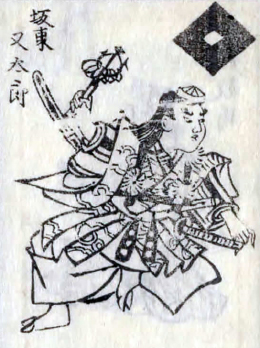 |
|||||
|
Band˘ Matatar˘ I in an ilustration from the book "Hana no Edo Kabuki Nendaiki" |
|||||
| Band˘ Matatar˘ II Band˘ Matatar˘ II |
|||||
|
Dates of birth and death unknown. He was the son of Band˘ Matatar˘ I and received at birth the name of Band˘ Ushinosuke [1]. He took the name of Band˘ Matajir˘ III when he started to do his training with his father. His father died the 28th of the 2nd lunar month of 1704 and he took the name of Band˘ Matatar˘ II the same year. He kept on acting a few years, appearing on stage for the last time in the 1st lunar month of 1710 at the Moritaza, where he performed as a wakashugata. No record afterwards. |
|||||
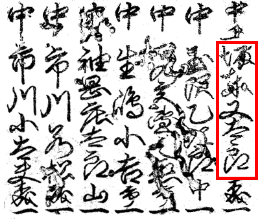 |
|||||
|
The name of Band˘ Matatar˘ II in the 1710 Edo hy˘banki (the zone within the red box) |
|||||
| Band˘ Matatar˘ III | |||||
|
The actor ďtani Hiroji II held the name of Band˘ Matatar˘ III from the 11th lunar month of 1736 to the 10th lunar month of 1743. |
|||||
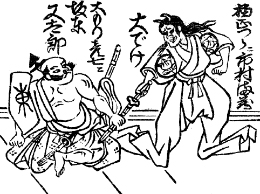 |
|||||
|
Band˘ Matatar˘ III (left) and Ichimura Manz˘ (right) playing the roles of ďmori Hikoshichi and Kusunoki Masatsura in the kaomise drama "Tokiwagi Taiheiki", which was staged in the 11th lunar month of 1739 at the Ichimuraza |
|||||
| Band˘ Matatar˘ IV | |||||
|
The actor Band˘ Matatar˘ IV held this name from the 11th lunar month of 1753 to the 9th lunar month of 1801. |
|||||
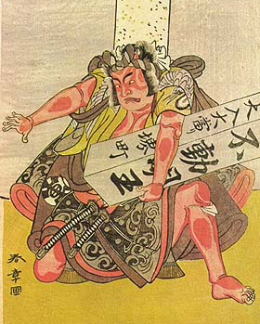 |
|||||
|
Band˘ Matatar˘ IV playing the role of Band˘ Tar˘ in the drama "Gohiiki Kanjinch˘", which was staged in the 11th lunar month of 1773 at the Nakamuraza (print made by Katsukawa Shunsh˘) |
|||||
| Band˘ Matatar˘ V Band˘ Matatar˘ V |
|||||
|
Dates of birth and death unknown. He started his career as a disciple of Sakata Hangor˘ IV, who gave him the name of Sakata Kumaemon. He became disciple of Ichimura Uzaemon XII and took in the 11th lunar month of 1832 the name of Band˘ Kumajűr˘ II at the Ichimuraza, playing in the drama "Band˘ Musha Tsunagate Hajime". He took the name of Band˘ Matatar˘ V in the 11th lunar month of 1838 at the Ichimuraza, playing the role of Kajiwara Heiz˘ Kagetoki in the drama "Gin Sekai Ikigoto no Kaomise". He held this name for less than a year, appearing on stage for the last time in the 6th lunar month of 1839, at the Ichimuraza, playing the roles of Yamana Jir˘zaemon, ďwashi Bungo and Sagisaka Bannai in the classic "Kanadehon Chűshingura". He most likely died in 1840. This tall actor was appreciated as supporting katakiyaku in jidaimono dramas.
|
|||||
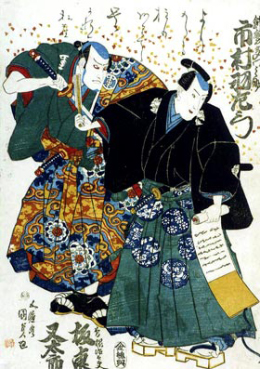 |
|||||
|
The actors Band˘ Matatar˘ V (left) and Ichimura Uzaemon XII (right) playing the roles of Sone Jidayű and Shikamata Monnosuke in a print made by Utagawa Kunisada I |
|||||
| Band˘ Matatar˘ VI Band˘ Matatar˘ VI |
|||||
|
Dates of birth and death unknown. He started his career as a disciple of Fujikawa Tomokichi II at the end of the 1810s, who gave him the name of Fujikawa Tomogor˘ [2]. He joined the star Nakamura Utaemon III at the beginning of the Tenp˘ era and received the name of Nakamura Tsurujűr˘. He was a supporting tachiyaku actor and later on became also katakiyaku. He joined a travelling troupe and was back in Edo in 1855, becoming a disciple of Ichimura Uzaemon XIII. He took the name of Band˘ Matatar˘ VI in the 3rd lunar month of 1855, performing at the Ichimuraza in the drama "Kagamiyama Gonichi no Ishibumi". He acted for 10 years in Edo theaters and appeared for the last time on stage in the 1st lunar month of 1865, at the Ichimuraza, performing in the new year drama "Tsuru no Chitose Soga no Kadomatsu". He most likely died in 1866. He was a good supporting katakiyaku and fukeyaku actor.
|
|||||
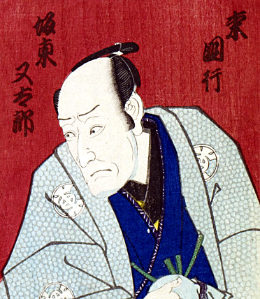 |
|||||
|
Band˘ Matatar˘ VI playing the role of Rai Kuniyuki in the drama "Shin Usuyuki Monogatari" in a print made by Utagawa Toyokuni III (1862~1863) |
|||||
| Band˘ Matatar˘ VII Band˘ Matatar˘ VII |
|||||
|
Born the 18th July 1922. He was the eldest son of the actor Band˘ Shűch˘ III. He made his first stage appearance as a koyaku in 1928 and later on took the name of Band˘ Matatar˘ VII. He gave up acting in 1948 and worked as a policeman for a short period of time. He became dance master in 1949.
|
|||||
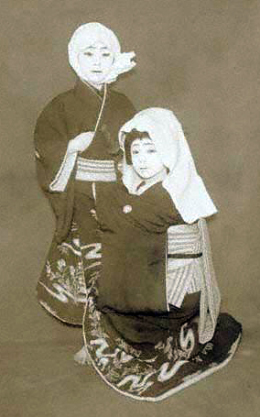 |
|||||
|
Band˘ Matatar˘ VII (top/left) and Ichikawa Miyosuke (bottom/right) playing the roles of Chűbŕ and Umegawa (t˘mi) in the drama "Ninokuchi-mura", which was staged in January 1934 at the T˘ky˘ Gekij˘ |
|||||
|
|
|||||
|
[1] This name was recorded in the latest edition (2012) of "Kabuki Haiyű Meiseki Benran" and in Nojima Jusabur˘'s book "Kabuki Jinmei Jiten"; it was not recorded in the Ritsumeikan Univ. Actors Database. [2] This name was recorded only in the latest edition (2012) of "Kabuki Haiyű Meiseki Benran"; it was not recorded in Nojima Jusabur˘'s book "Kabuki Jinmei Jiten" or in the Ritsumeikan Univ. Actors Database. He was a disciple of both Fujikawa Tomokichi II and Fujikawa Tomokichi III. |
|||||
|
|
| Contact | Main | Top | Updates | Actors | Plays | Playwrights | Programs | Links | FAQ | Glossary | Chronology | Illustrations | Prints | Characters | Derivatives | Theaters | Coming soon | News |